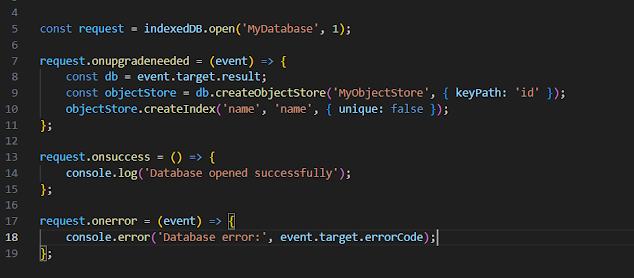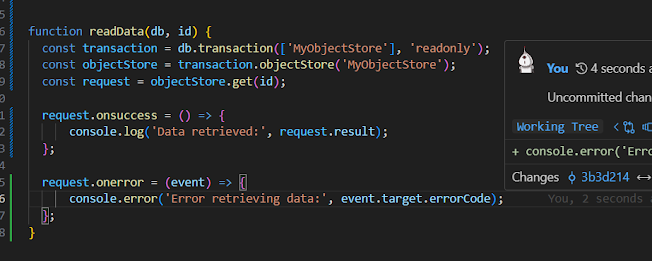In the realm of web storage, we often focus on Local Storage and Session Storage, but many developers overlook a powerful option that can significantly enhance their applications: IndexedDB. While Local and Session Storage are great for simple key-value pairs, IndexedDB offers a robust solution for managing larger amounts of structured data. In today’s post, I’ll explore the concept of IndexedDB, its advantages, and guide you through basic CRUD operations. Let’s dive into this essential browser database and discover how it can elevate your web development projects. I’d love to hear your thoughts and insights along the way!
⚡ What is IndexedDB?
- Asynchronous API: IndexedDB operations are primarily asynchronous, which means they won’t block the main thread. This is particularly important for performance in web applications.
- Large Storage Capacity: Unlike Local Storage, which has a storage limit of about 5-10 MB, IndexedDB can handle large amounts of data (hundreds of MBs or more, depending on the browser).
- Structured Data: You can store not only simple key-value pairs but also complex objects, arrays, and even files.
- Transactions: IndexedDB supports transactions, allowing you to group operations together for consistency.
- Indexes: You can create indexes to improve the efficiency of searches.
⚡ Basic CRUD Operations with IndexedDB
Read (Retrieve Data)
You can retrieve data using get, getAll, or by using an index.
Update (Modify Data)
To update data, you can use the put method.
Delete (Remove Data)
To delete data, you can use the delete method.
⚡ Differences from Other Web Storage
- Capacity: IndexedDB can store much larger amounts of data compared to Local Storage (5-10 MB).
- Data Type: IndexedDB allows complex data types (like objects and arrays) while Local Storage only supports string key-value pairs.
- Querying: IndexedDB supports indexing and transactions, allowing for efficient querying and manipulation of data.
- Asynchronous: Unlike Local Storage, which operates synchronously, IndexedDB’s operations are asynchronous, making it suitable for complex applications.
⚡ Use Cases
- Offline Applications: IndexedDB is ideal for web apps that need to function offline, as it allows for the storage of data that can be accessed without an internet connection.
- Caching: Web applications can cache data (e.g., API responses) in IndexedDB for faster access and reduced server load.
- Complex Data Structures: Applications requiring storage of complex data structures, such as games or data-heavy apps (like a photo gallery), can utilize IndexedDB effectively.
- Persistent Data: For applications that require long-term data storage (like user preferences or application settings), IndexedDB is a good choice.
⚡Advanced Concepts
onupgradeneeded event.⚡ Full Example Code
// Open the IndexedDB databaseconst request = indexedDB.open('MyDatabase', 1);request.onupgradeneeded = (event) => {const db = event.target.result;const objectStore = db.createObjectStore('MyObjectStore', { keyPath: 'id' });objectStore.createIndex('name', 'name', { unique: false });};request.onsuccess = (event) => {const db = event.target.result;// Sample dataconst sampleData = { id: 1, name: 'John Doe', age: 30 };// Adding dataaddData(db, sampleData);// Reading datareadData(db, 1); // Fetch the data by id// Updating dataconst updatedData = { id: 1, name: 'John Smith', age: 31 };updateData(db, updatedData);// Reading updated datareadData(db, 1); // Fetch the updated data// Deleting datadeleteData(db, 1); // Delete the data by id// Trying to read deleted datareadData(db, 1); // Fetch again to check if it's deleted};request.onerror = (event) => {console.error('Database error:', event.target.errorCode);};// Function to add datafunction addData(db, data) {const transaction = db.transaction(['MyObjectStore'], 'readwrite');const objectStore = transaction.objectStore('MyObjectStore');const request = objectStore.add(data);request.onsuccess = () => {console.log('Data added successfully');};request.onerror = (event) => {console.error('Error adding data:', event.target.errorCode);};}// Function to read datafunction readData(db, id) {const transaction = db.transaction(['MyObjectStore'], 'readonly');const objectStore = transaction.objectStore('MyObjectStore');const request = objectStore.get(id);request.onsuccess = () => {if (request.result) {console.log('Data retrieved:', request.result);} else {console.log('No data found with this id.');}};request.onerror = (event) => {console.error('Error retrieving data:', event.target.errorCode);};}// Function to update datafunction updateData(db, data) {const transaction = db.transaction(['MyObjectStore'], 'readwrite');const objectStore = transaction.objectStore('MyObjectStore');const request = objectStore.put(data);request.onsuccess = () => {console.log('Data updated successfully');};request.onerror = (event) => {console.error('Error updating data:', event.target.errorCode);};}// Function to delete datafunction deleteData(db, id) {const transaction = db.transaction(['MyObjectStore'], 'readwrite');const objectStore = transaction.objectStore('MyObjectStore');const request = objectStore.delete(id);request.onsuccess = () => {console.log('Data deleted successfully');};request.onerror = (event) => {console.error('Error deleting data:', event.target.errorCode);};}








Comments
Post a Comment